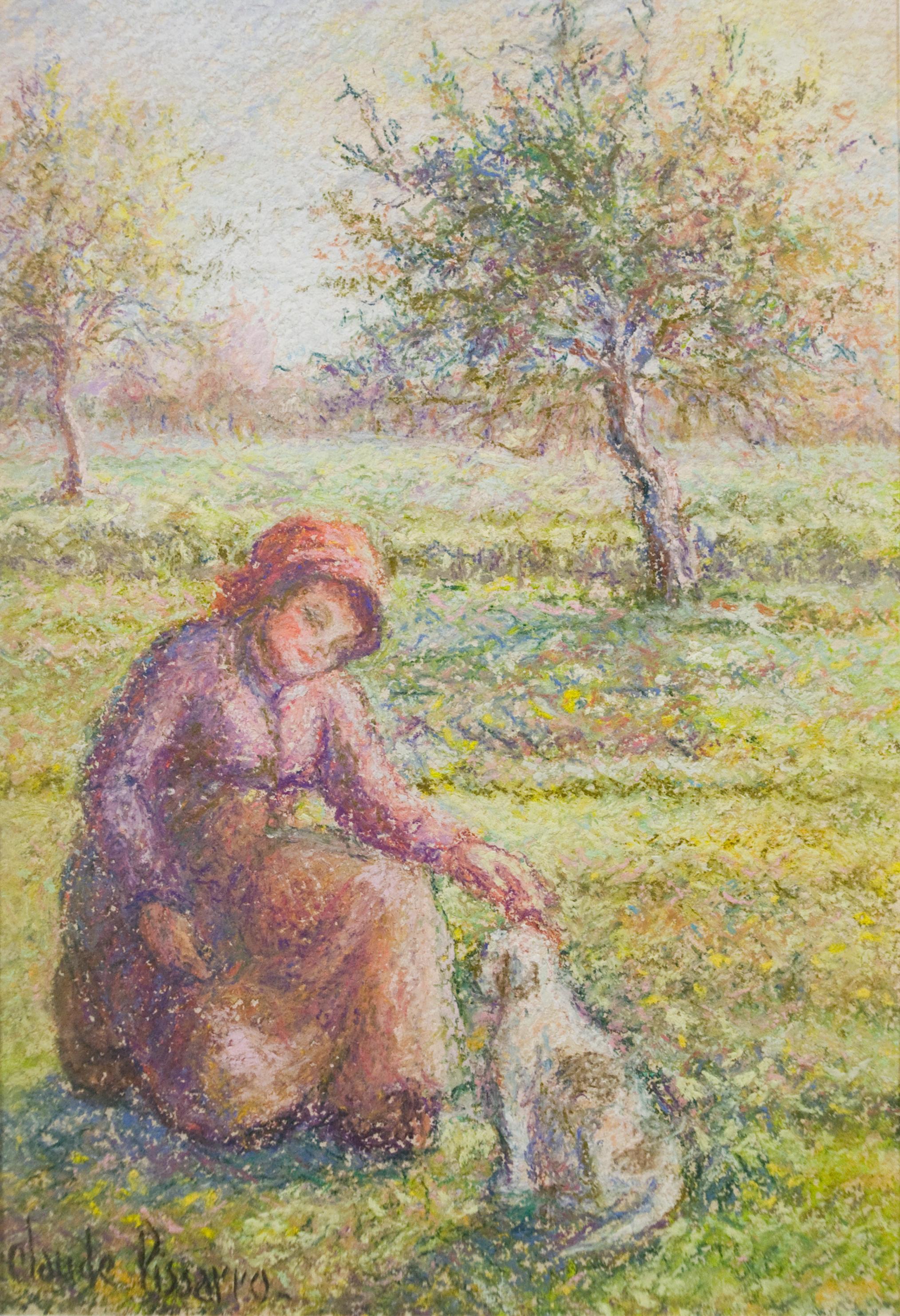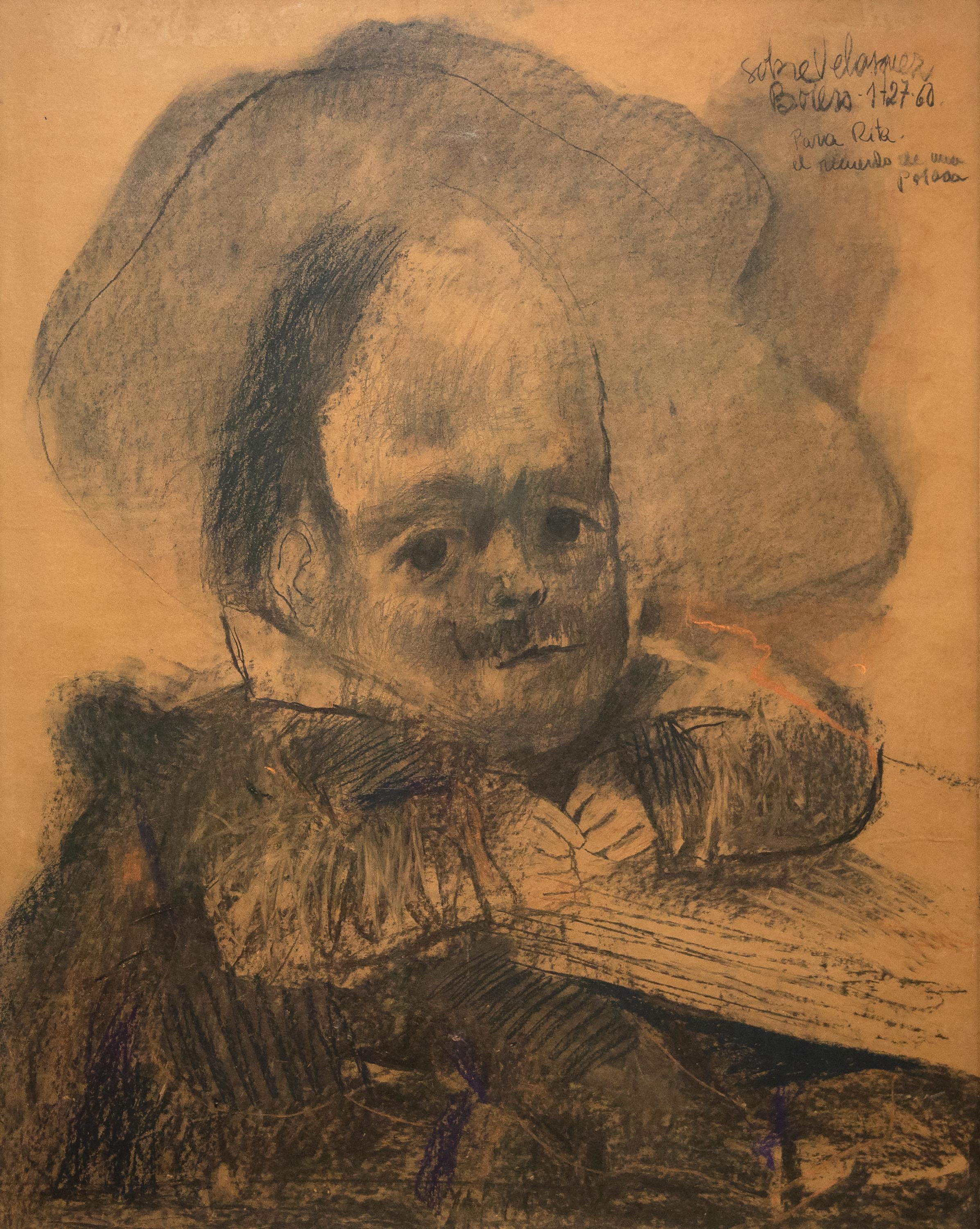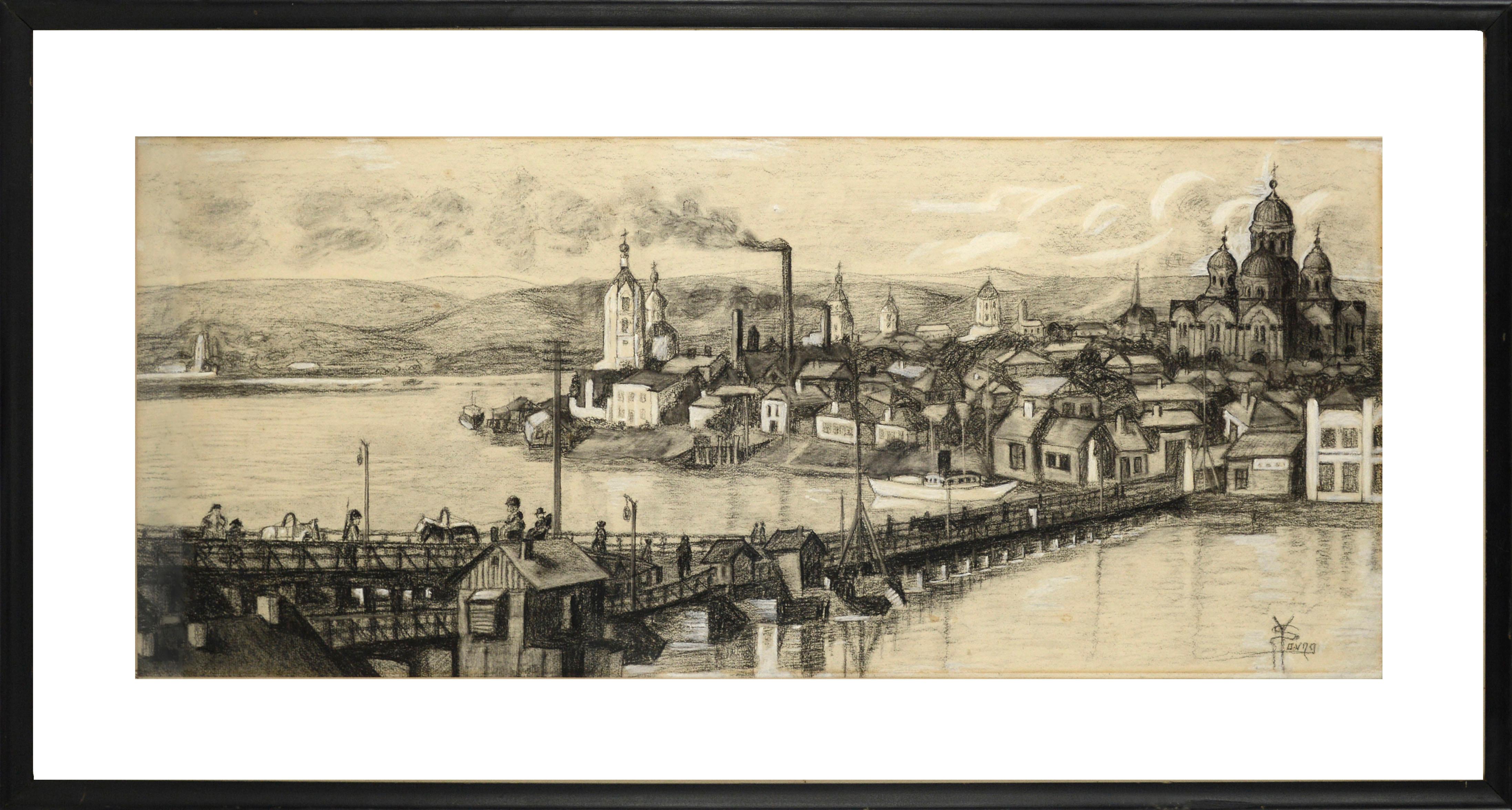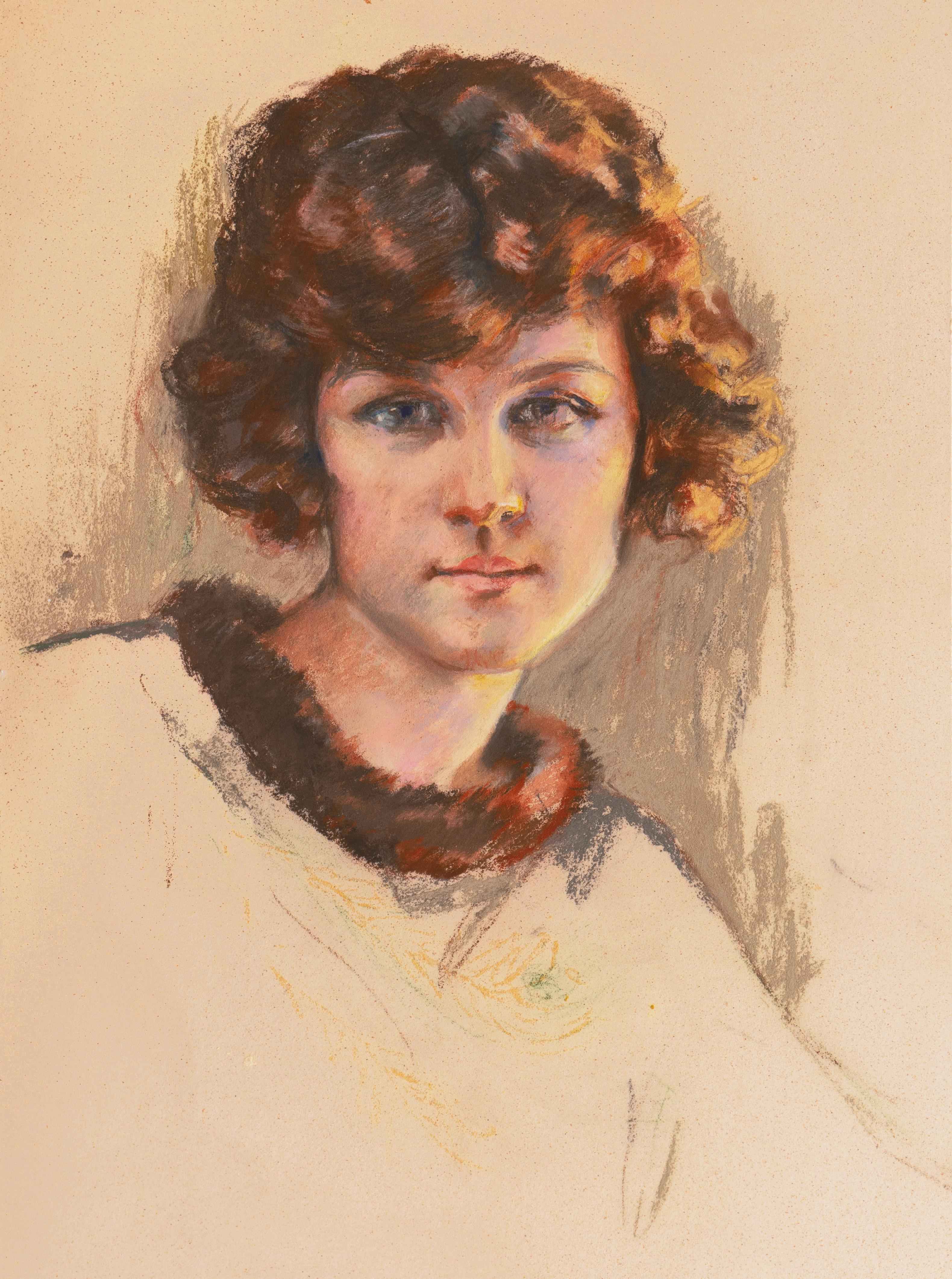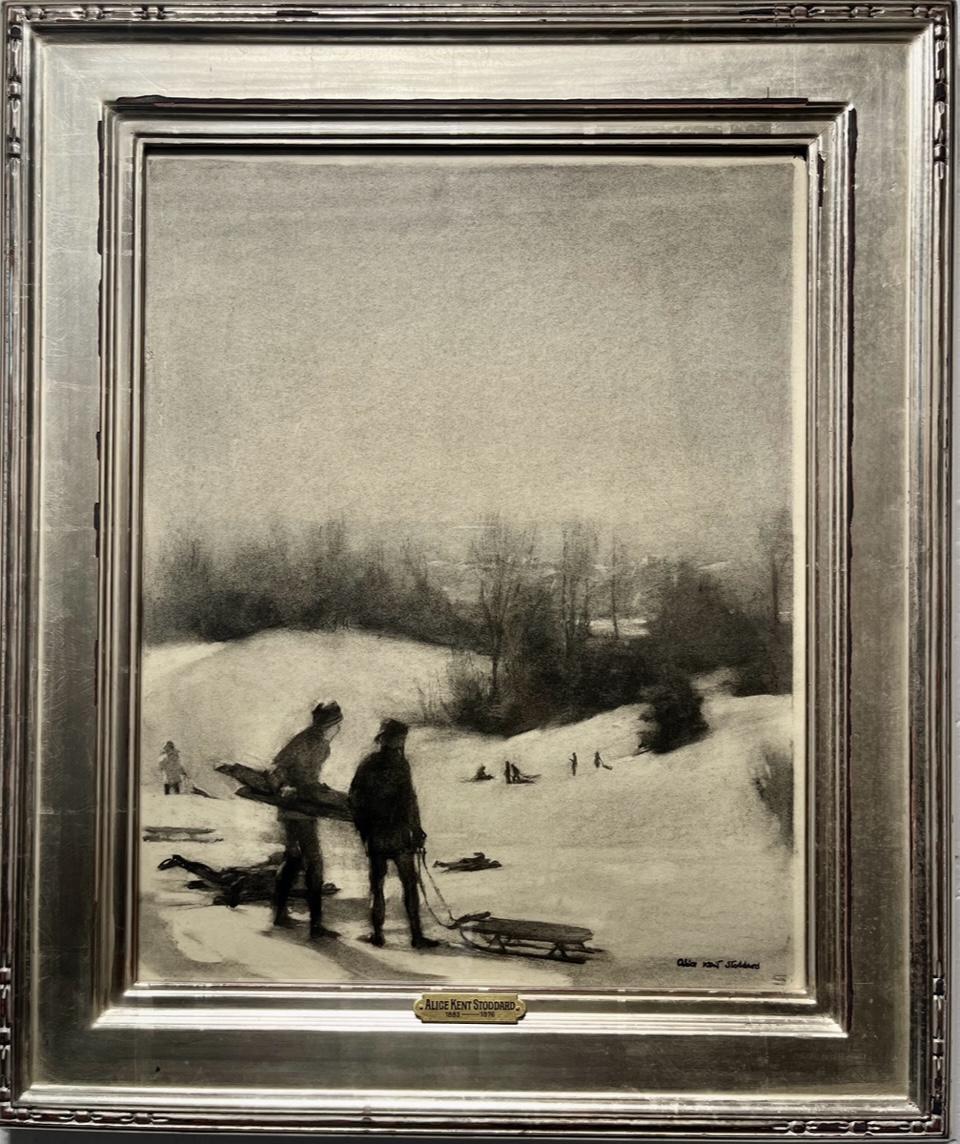Edgar DegasUkrainian Dancers By Edgar DegasCirca 1899
Circa 1899
About the Item
- Creator:Edgar Degas (1834-1917, French)
- Creation Year:Circa 1899
- Dimensions:Height: 46 in (116.84 cm)Width: 36 in (91.44 cm)
- Medium:
- Movement & Style:
- Period:
- Condition:
- Gallery Location:New Orleans, LA
- Reference Number:
Edgar Degas
Edgar Degas, born Hilaire-Germain-Edgar De Gas in Paris in 1834, was the oldest of five children of Célestine Musson De Gas, a Creole from New Orleans, and Augustin De Gas, a banker. Degas began his schooling at age eleven, enrolling in the Lycée Louis-le-Grand, but after his mother died when he was thirteen, his father and grandfather became the main influences on him for the remainder of his youth.
Upon graduating the Lycée in 1853, at age 18, he registered as a copyist in the Louvre Museum, but his father expected him to go to law school. Degas duly enrolled at the faculty of law of the University of Paris, in November 1853, but applied little effort to his studies. In 1855, Degas met Jean-Auguste-Dominique Ingres, whose advice he never forgot: “Draw lines, young man, and still more lines, both from life and from memory, and you will become a good artist.” In April of that year, Degas was admitted to the École des Beaux-Arts.
Evidence of Degas’ classical education can be seen in his early painting, Young Spartans Exercising (ca. 1860; National Gallery, London), done while he was still in his twenties. After 1865, when the Salon accepted his history painting The Misfortunes of the City of Orléans (Musée d'Orsay, Paris), Degas did not paint Academic subjects again, focusing his attention on scenes of modern life. He began to paint scenes of such urban leisure activities as horse racing and, after about 1870, of café-concert singers and ballet dancers. Degas' interest in ballet dancers intensified in the 1870s, and eventually he produced approximately 1,500 works on the subject. These are not traditional portraits, but studies that address the movement of the human body, exploring the physicality and discipline of the dancers through the use of contorted postures and unexpected vantage points.
Following the opening of trade with Japan in 1854, many French artists, including Degas, were increasingly influenced by Japanese prints. Degas abstracted from these prints their inventive compositions and points of view, particularly in his use of cropping and asymmetry [Dancers Practicing at the Bar (1877); Dancers, Pink and Green (ca. 1890)]. He also observed how sixteenth-century Italian Mannerists similarly framed their subjects, sometimes cutting off part of a figure.
Degas had an interest in a wide range of media, including engraving, monotype, and photography. Before 1880, he generally used oils for his completed works, but after 1875, he began using pastels more frequently, even in finished works such as Portraits at the Stock Exchange (1876). He submitted a suite of nudes, all rendered in pastel, to the final Impressionist exhibition in 1886; among these was Woman Bathing in a Shallow Tub (1885). The figures in these pastels were criticized for their ungainly poses.
By the late 1880s, Degas’s eyesight had begun to fail, perhaps as a result of an injury suffered during his service in defending Paris during the Franco-Prussian War of 1870–71. After that time he focused almost exclusively on dancers and nudes, increasingly turning to sculpture. Degas continued working as late as 1912, when he was forced to leave the studio in Montmartre in which he had labored for more than twenty years. He died five years later in 1917, at the age of eighty-three.
Find original Edgar Degas drawings, prints, paintings and other art on 1stDibs.
(Biography provided by Stern Pissarro Gallery)
- ShippingRetrieving quote...Ships From: New Orleans, LA
- Return PolicyThis item cannot be returned.
- Danseuse By Pierre Carrier-BelleuseBy Pierre Carrier-BelleuseLocated in New Orleans, LAPierre Carrier-Belleuse 1851-1932 | French Danseuse Signed “Pierre Carrier-Belleuse” (lower right) Pastel on canvas Strikingly elegant, this extraordinary pastel by French impress...Category
19th Century Impressionist Figurative Drawings and Watercolors
MaterialsPastel, Canvas
- Musiciens Sur Fond Multicolore By Marc ChagallBy Marc ChagallLocated in New Orleans, LAMarc Chagall 1887-1985 Russian Musiciens sur fond multicolore (Musicians on a multicolored background) Signed 'Chag' (on the sleeve of the right figure); stamped with the signature 'Marc Chagall' (lower right) Tempera, gouache, colored ink and India ink and pastel on paper “The fact that I made use of cows, milkmaids, roosters and provincial Russian architecture as my source forms is because they are part of the environment from which I spring and which undoubtedly left the deepest impression on my visual memory of the experiences I have." - Marc Chagall Marc Chagall’s 1981...Category
20th Century Post-Impressionist Figurative Drawings and Watercolors
MaterialsPaper, Pastel, Ink, India Ink, Tempera, Gouache
- La femme préhistorique (Prehistoric Woman)By James Jacques Joseph TissotLocated in New Orleans, LAJames Tissot was among the most successful and critically acclaimed artists of the Victorian era. Although the artist is celebrated for his elegant scenes of fashionable life in Paris and London, this work is a fascinating rarity within his oeuvre. In this monumental pastel, Tissot depicts a prehistoric woman draped in a tiger skin, presented with a striking pose and heroic air. His delicate portraiture, combined with his fascination with conveying texture, demonstrates why he was one of the most revered artists of his generation, and La femme préhistorique illustrates the remarkable technique for which he was renowned. This work was completed in preparation for a series of works exploring the Old Testament undertaken by Tissot from 1899-1902 that remained unfinished at the time of his death. A portion of this series focused on illustrations of Adam and Eve, and among these sketches were images of a nude Eve partially draped in animal furs. Towards the end of his life, following his conversion to Catholicism, biblical subjects became important to the artist. A few years before this work was completed, Tissot embarked upon a highly ambitious group of nearly 300 watercolors illustrating the New Testament, presenting the illustrated epic in its entirety at the Paris Salon of 1894. Both of these series were a critical artistic departure for the artist, stemming from a desire to create works separated from his typical images of modern society. This pastel imagines Eve as the prototype of womanhood in the guise of a prehistoric woman. Tissot rarely painted the nude, and his skill as a draftsman highlights the figure's natural beauty, contrasting it with the stark landscape surrounding her. Although a study, this monumental work is incredibly well-finished and highly engaging, with the statuesque model commanding the majority of the canvas. Her pose is strong and theatrical, and she addresses the viewer with a direct, confident gaze. The imagined historical subject of this drawing is grounded by Tissot’s exceptional attention to detail. A master of conjuring an array of textures, Tissot showcased this ability in this work by juxtaposing many types of fabrics and natural elements within one composition. The tiger skin with which the woman partially covers herself was a favorite studio prop of Tissot’s, appearing in many of his most influential works from the period, including several paintings of his partner and favorite model Kathleen Newton. It, in particular, showcases the artist’s understanding of texture, yet it also serves as an exotic element that elevates the sensuality of the scene when placed against the woman’s bare skin. Born in 1836 in the port town of Nantes, Tissot traveled to Paris at the age of 20 in order to join the studios of Hippolyte Flandrin and Louis Lamothe. During this period, he became close with James Abbott McNeill Whistler, Edgar Degas and Edouard Manet, and the impact of these friendships is reflected in his portraits of modern life. Having enjoyed considerable success in Paris during the 1860s, Tissot fought in the Siege of Paris, and after the fall of the Commune in 1871, he went to London, where he stayed for the next ten years. He was met with incredible success there, and he also met the love of his life, Kathleen Newton, a divorcée, with whom he lived from about 1876 until her death in 1882. Today he is regarded among the great masters of Belle Époque painting, and his works can be found in important collections worldwide, including the Metropolitan Museum of Art, the Brooklyn Museum, the National Gallery of Art, the Musée d’Orsay, the Tate Gallery and many others. This pastel remained in Tissot's private collection until his death in 1902 and is referenced in the posthumous 1902-3 valuation of Tissot's home at 64 avenue du Bois...Category
Early 20th Century Academic Nude Drawings and Watercolors
MaterialsLaid Paper, Canvas, Oil Pastel, Pastel
- Le Fondeur De Bronze By Lucien Lévy-DhurmerBy Lucien Levy-DhurmerLocated in New Orleans, LALucien Lévy-Dhurmer 1865-1953 French Le fondeur de bronze Signed "Levy Dhurmer" (lower right) Pastel on paper French painter Lucien Lévy-Dhurmer was one of the leading artists of...Category
Early 20th Century Post-Impressionist Figurative Drawings and Watercolors
MaterialsPaper, Pastel
- Portrait Of A Young Woman Attributed To Frank Weston BensonBy Frank Weston BensonLocated in New Orleans, LAAttributed to Frank Weston Benson American 1862-1951 Portrait of a Young Woman Watercolor on paper Signed “F.W. Benson 1912” (lower right) This watercolor painting, entitled Port...Category
20th Century Impressionist Figurative Drawings and Watercolors
MaterialsPaper, Watercolor
- Caricatures Of Queen Victoria And Edward VII By Sir Leslie Matthew Ward (Spy)Located in New Orleans, LASir Leslie Matthew Ward (aka Spy) 1851-1922 British Caricatures of Queen Victoria and Edward VII Charcoal on paper These satirical caricatures of Queen Victoria and Edward VII of...Category
Early 20th Century Figurative Drawings and Watercolors
MaterialsPaper, Charcoal
- Céline et Pipo dans le préBy Hughes Claude PissarroLocated in Washington, DCAccompanied by certificate no. 2772163 from the artist's archives.Category
2010s Impressionist Figurative Drawings and Watercolors
MaterialsPastel, Cardboard
- Dibujo a la manera de Velasquez (Drawing in the Manner of Velasquez)By Fernando BoteroLocated in Palm Desert, CAA drawing by Fernando Botero. "Dibujo a la Manera de Velasquez" is a portrait, charcoal and pastel on cardboard in an earth-tone palette by Latin American artist Fernando Botero. It is signed upper right, "Sobre Velazquez Botero -1-27-60 Para Rita. el recuerdo de uno payaso". Fernando Botero, best known for his voluptuously rotund human figures, was born in Medellín, Colombia on April 19, 1932. His father died when he was young, and he was raised by his mother, along with his two brothers. He attended a Jesuit school in Medellín and from the age of 12 to 14, he attended a matador training school. The bull fight became a recurring theme in Botero’s early work and while he was in his early teens, he sold his pictures of bull fights in front of the arena. By the time he was 16 years of age, Botero was working as an illustrator for the local magazine El Colombiano. He also began writing articles about art theory, one of which, entitled Picasso and Non-Conformity in Art, led to his expulsion from the Jesuit school for its endorsement of Cubism. One of Botero’s important early works, Woman Crying...Category
Mid-20th Century Post-War Portrait Drawings and Watercolors
MaterialsCharcoal, Pastel, Cardboard
- View of Tallinn, Estonia - Figurative Landscape Panoramic Charcoal DrawingLocated in Soquel, CAA sweeping view of Tallinn, Estonia by an unknown artist (20th Century). This detailed charcoal landscape drawing shows a panorama of the beautiful coastal city on the Baltic Sea, complete with small figures walking on a pier, boats in the harbor, and the iconic Alexander Nevsky...Category
Early 20th Century Impressionist Landscape Drawings and Watercolors
MaterialsCharcoal, Paper, Pastel
- 'Vancouver Girl', Young Woman with Bobbed Copper Hair, AIC, Paris, New YorkLocated in Santa Cruz, CASigned verso, 'George Wilburton Colby' (American, 1859-1922) and dated 1920. George Colby was a member of the old Art League and a life member of the Chicago Art Institute. After hi...Category
1920s Impressionist Figurative Drawings and Watercolors
MaterialsPaper, Pastel, Illustration Board
- Sledders - Winter Snow Scene - Kids playing on Sleds, Charcoal drawing c 1950-60By Alice Kent StoddardLocated in Rancho Santa Fe, CAAlice Kent Stoddard 1885-1976 Sledders (circa 1950-1960) Black chalk on card Image Dimensions: 19.75 x 16 inches (50.2 x 40.6 cm) Framed Dimensions: 26.5 x 22.3 inches Signed lower...Category
Mid-20th Century American Impressionist Figurative Drawings and Watercolors
MaterialsCharcoal, Cardboard
- Portrait of a Man with White Hair and Mustache in Pastel on Artist's BoardBy Honora BergLocated in Soquel, CAPortrait of a Man with White Hair and Mustache in Pastel on Cardstock Portrait of a man by Honora Berg (American, 1897-1985). The man is looking directly at the viewer, with a neutral expression. He has white hair and a mustache, and is wearing a brown suit with a red tie. Signed "Honora Berg" in the bottom right corner. Stamp from Miller Fine Art on verso Acquired with a collection of the artist's work. Initialed and numbered "HB 117" on verso Unframed. Board size: 20"H x 15"W Honora Berg (American, 1897-1985) was an Abstract Expressionist and Bay Area Figurative School artist who studied at the San Francisco Art Institute with David Park, Elmer Bischoff and James Budd Dixon. Berg's friend Edith Truesdell — David Park's aunt — suggested a move to California in 1951 to study under Park. She exhibited at the 25th Annual Drawing, Print and Sculpture Exhibition at the San Francisco Museum of Modern Art, 1961. Provenance, Estate of Honora Berg - David Carlson Gallery, Larry Miller...Category
1950s American Impressionist Portrait Drawings and Watercolors
MaterialsOil Pastel, Canvas, Cardboard
Recently Viewed
View AllRead More
Wear Louis Comfort Tiffany’s Genius on Your Finger with This Vivid Ring
In his jewelry making, the designer rarely used diamonds — this rare example has two.
You Won’t Find a More Handsome Stopwatch Than This 1890s Pocket Chronograph
A Grand Complication from the golden era of pocket watches, the Marius Lecoultre pocket watch does everything but uncork your wine.
